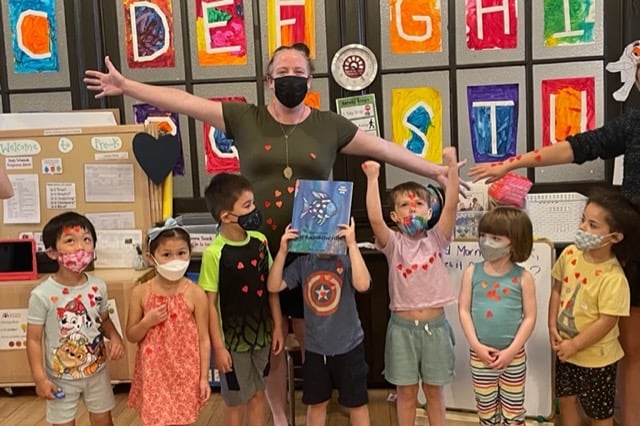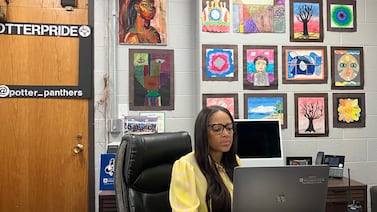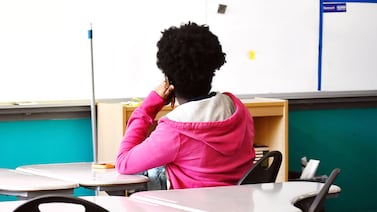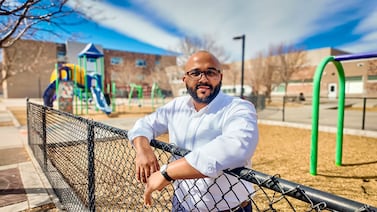This story is featured in Chalkbeat’s 2022 Philadelphia Early Childhood Education Guide on efforts to improve outcomes for the city’s youngest learners. To keep up with early childhood education and Philadelphia’s public schools, sign up for our free weekly newsletter here.
For many parents, this year has marked a return to “normal” — with COVID restrictions largely lifted and workplaces open once again.
The transition has been harder for young children. Today’s preschoolers were babies and toddlers during the pandemic lockdowns, and some missed out on early opportunities to be around educators and peers.
“For many of my students, this is their first time in a school or care setting, or even leaving their house” for extended periods of time, said Lyssa Horvath, a lead pre-K teacher at Belmont Academy Charter School in Philadelphia.
To meet students’ needs, Horvath has adjusted her approach. “In addition to the language, math, physical, social, and emotional development that I typically do in my classroom, I’m engaged in a lot more confidence boosting and encouragement than in years before,” she said.
This is Horvath’s first year at Belmont Academy, but she has taught preschool for more than a decade. She’s also a policy fellow with Teach Plus Pennsylvania, a mentor teacher, and a preschool curriculum developer. Horvath spoke recently with Chalkbeat Philadelphia about teaching preschoolers to share, common misconceptions about early learners, and how young children use behavior to communicate their needs.
This interview has been lightly edited for length and clarity.
Why did you decide to become a preschool teacher?
I didn’t choose preschool, preschool chose me. I thought I wanted to be a middle school English Language Arts teacher, and that is what my original certification is in. However, my first job was a summer position at Merritt Academy in Virginia, teaching across age levels. When September approached, I was asked if I wanted to stay on as a lead teacher in a pre-K 3 classroom, which I happily accepted. After one year, I knew early childhood education was the place for me. Guiding so much important brain, social, and emotional development is a huge responsibility, and I get to do it with curiosity, joy, and laughter every day.
What’s your favorite lesson to teach and why?
I love lessons that focus on social and emotional skills, helping children manage emotions, establish relationships, set goals, and make responsible decisions. One of my favorite lessons to do around the December holidays centers on the story about sharing, “Rainbow Fish” by Marcus Pfister. After reading the book, I give each child a sheet of shiny fish stickers and ask what we should do with them. A choir of voices usually responds with “share them!” We take a few minutes to stand up and put our stickers on our friends, laughing and giggling the whole time. As you can imagine, by the end of the lesson everyone is covered in their peer’s stickers.
I conclude the lesson by discussing how it feels to share and give something to someone else and how it felt to get the stickers. Children agree it feels just as good to give as it does to receive. Then the kids brainstorm and list other small acts of kindness they can give in the classroom or at home. The goal of the lesson is to teach children that generosity, like sharing a smile, a hug, a story, or a compliment, helps to develop positive relationships with peers and family members.
What’s something happening in the community that affects what goes on inside your classroom?
In many ways, the communities we serve are rebooting, and there is a lot of disruption. Students are headed back to school, parents are back at work (many of my students’ parents have more than one job), schedules are changing, and cold viruses are spreading. Adults are returning to a familiar way of life, but this is unfamiliar for kids under five who have spent the majority of their lives in a pandemic environment.
In the classroom, this translates to insecurity and introversion. They struggle with how to move in a room full of other children, sharing, taking turns, or simply playing with others. On the flip side, these children have formed strong, secure attachments with their caregivers, which is translating to strong, secure attachments with their teachers and peers.
What advice would you give someone considering a career in early childhood education?
First, see if this is the right fit for you. Visit and observe all types of schools and all ages, birth to five. Learn about Maria Montessori, Emilia Reggio, and play-based schools. Visit a Head Start, charter, or traditional public school, or one of the academically focused centers. Early childhood education is incredibly rewarding, and also incredibly hard, so find what sparks your passion the most and know that the work you are choosing is incredibly important and worthwhile. Connect with the teacher advocacy groups in your area, Teach Plus, First Up, and Children First have all been incredible sources of professional development and building my teacher network. Being involved with these organizations has allowed me to meet teachers outside of my school and strengthen my own teaching practice.
What’s a common misconception about preschool and/or early learners?
A common misconception about preschool and early learners is that their learning looks like typical elementary school learning and that small children sit and receive instruction directly from the teacher. This couldn’t be further from the truth. Early learners’ brains are still developing, mapping, and making connections. They learn by active participation, trial and error, exploration, and investigation. They learn by doing and for young children doing is playing. This is why I’m working with Teach Plus, raising my voice as an early childhood educator to advocate for what is best for young learners.
I understand that you help develop other early learning centers develop their curriculums. Tell me about that work and what makes a strong preschool curriculum.
I had the opportunity to work for a nationwide early learning center as a curriculum developer. My main project was rewriting the phonics program for 4- and 5-year-olds to reflect current research and best practices.
To me, a good preschool curriculum meets students where they are, engages them in developmentally appropriate practices, makes space for students to practice and reinforce skills, and allows multiple ways to demonstrate mastery of skills. Good preschool curriculum is child-focused, allows children to make independent choices, and allows lots of time for play. Good preschool curriculum engages teachers as room facilitators, or composers — bringing out the best in each student — as opposed to technicians rushing through scripts.
What’s the best advice you’ve ever received, and how have you put it into practice?
The best advice I’ve ever received is that behavior is communication. This changed the way I manage my classroom and see my students. What I used to see as misbehavior I now know is an unmet need of a child that I need to address, whether it is feeling secure, managing emotions, or responding to internal body cues. With this orientation, I understand my students better and help them understand their needs and how to best meet them.








